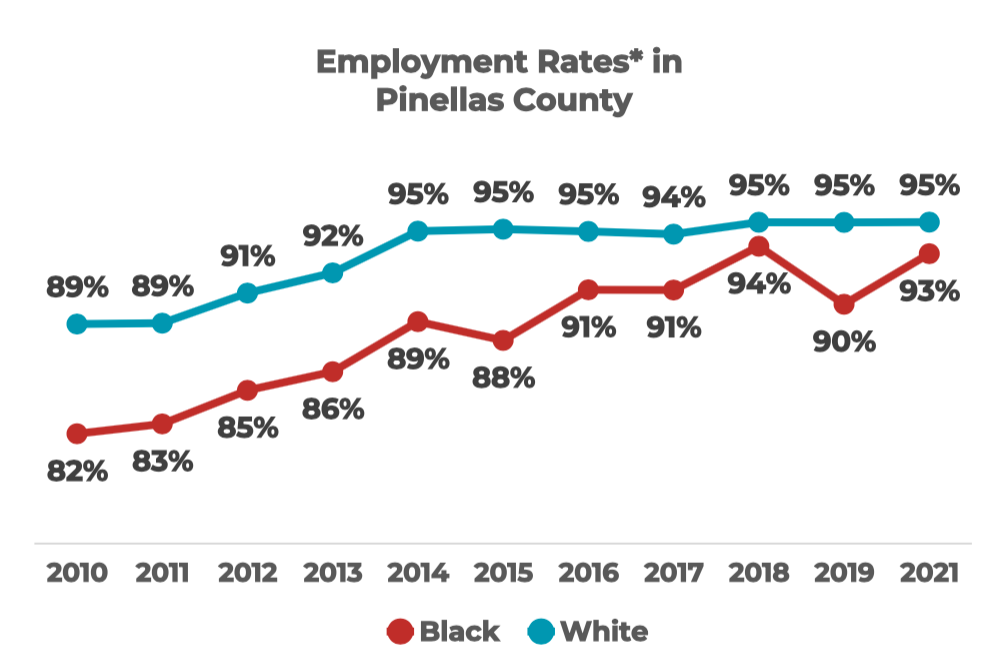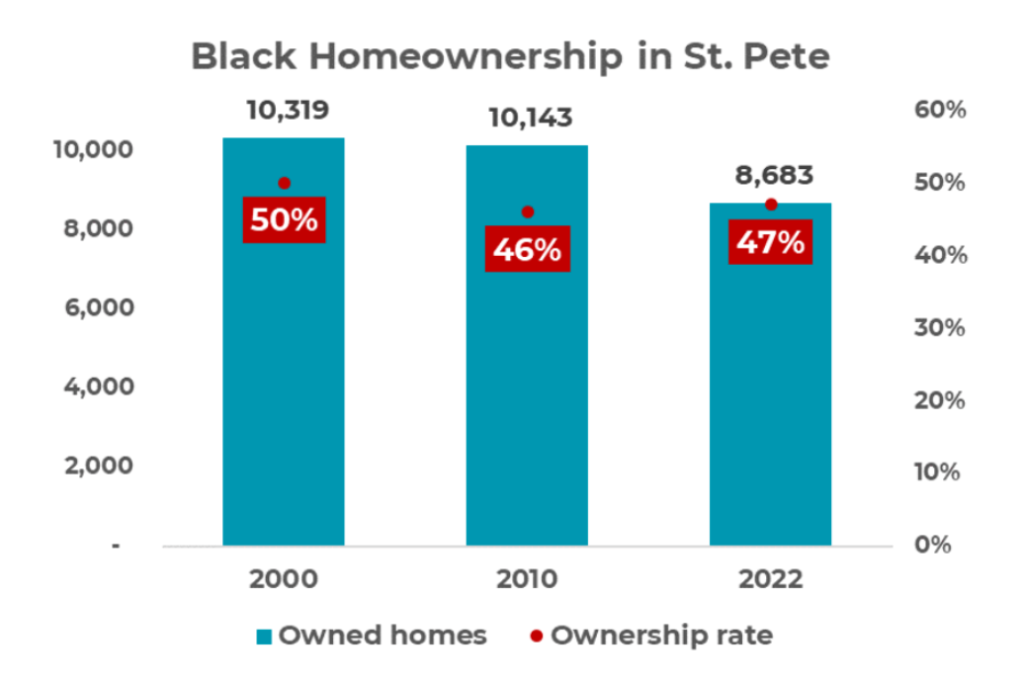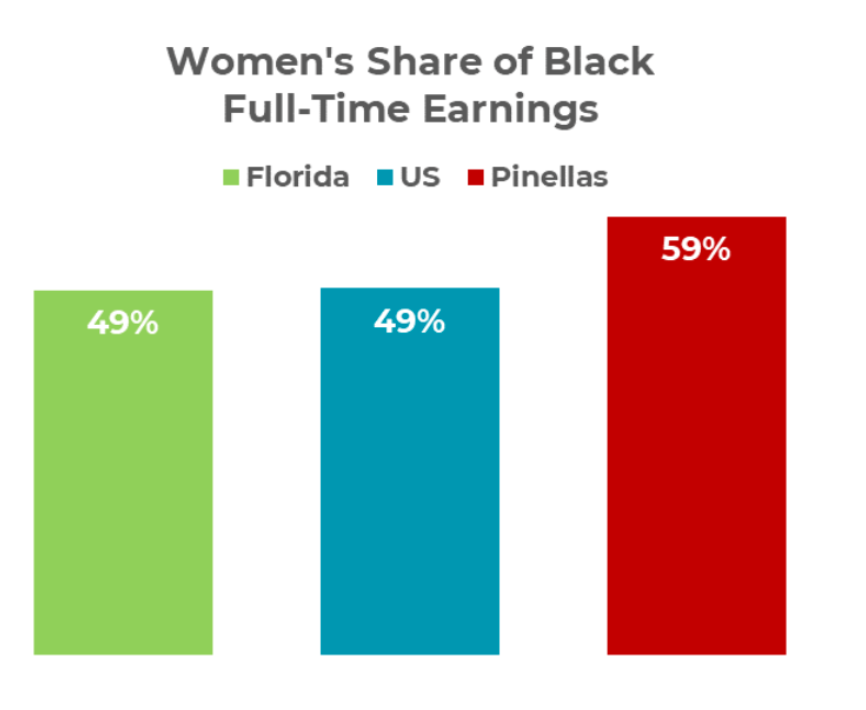
Later this week, community leaders will gather for a summit on the economic future of African Americans in St. Petersburg. Organizers expect a full house for what they hope will be part one in a serious dialogue to explore “innovative strategies” to shape the future.
The event is called the South St. Petersburg Economic Conference and it happens this Thursday, April 25th at 6 pm at the Enoch Davis Center.
This Quick Brief was created to support the dialogue with some of the latest data on the economic standing of African Americans in Pinellas County and St. Petersburg.
It draws from analysis done in 2023 that examined changes in 50+ measures of economic well-being for African Americans, from 2010 to 2021 (with a few data points from the most recent census release, for 2022).
First, the Good News
African Americans in Pinellas have made record-setting economic progress in recent years. For most of the past decade, they paced ahead of their race peers across Florida and the U.S. in education and employment gains, and in some metrics, also outpaced their White neighbors.
Gains were most impressive in career-track education. Thanks in part to local institutions such as St. Petersburg College, 57% of Black adults in Pinellas have at least some college education and 20,500 have a college degree (Associate’s or higher).
Since 2010, African Americans’ labor force participation rate is up and their employment rate rose to a record 94% in 2018, creating the smallest White-Black unemployment gap of the 21st century.

*Percent of people in the labor force who are employed
Partly as a result, Black poverty has reached an all-time low in St. Pete and Pinellas. The
rate in 2022 was the lowest ever recorded for the county (19.4%).
One of the most emphatic indicators of progress is the rise in African Americans in
management, business & professional occupations. This group has become a plurality (i.e.,
the largest share) of the Black workforce.
Over 15,600 Black Pinellas residents worked in management, business and professional jobs in 2022.
We also see encouraging news in the criminal legal system. Arrests and incarceration rates are down for African Americans in the county, which means more Black workers are available to participate in the economy.
The aggregate income of Black residents of Pinellas surpassed $2.5 billion in
2022, with 43,500 resident Black workers contributing to the local economy.
Yet Most Racial Gaps Have Widened
African Americans have significantly narrowed some gaps such as the high school
graduation and college enrollment gaps, but most gaps have widened.
- The White-Black earnings gap grew substantially.
- The homeownership gap grew.
- And based on limited data, the wealth gap also grew.
The graph below charts the earnings gap over time for White versus Black workers in Pinellas, and the difference between the two.
Despite a significant narrowing of education and employment gaps, the racial
earnings gap is wider today than it was in the year 2000.
In 2000, White workers earned 65% more than Black workers; by 2022, the White workers’ earnings edge was 68%.

African Americans Are the Only Group That Slid Backwards
African Americans are the only race group that lost ground in earnings and
homeownership over the years analyzed.
From 2010 to 2021, White, Asian, and Hispanic workers experienced real earnings growth (“real” meaning their earnings grew faster than inflation). African Americans
did not, despite having stronger education and employment gains than most.
In addition, African Americans were the only group with a net loss in both owned homes and homeownership rate. Though the Black homeownership rate is higher in St. Pete (compared to the rest of Pinellas), the number of Black-owned homes in the city shrank by 14% between 2010 and 2022 and the Black homeownership rate is lower today (47%) than it was in 2000 (50%).

The Crushing Effect of Housing Costs
While all racial and ethnic groups are grappling with the affordable housing shortage, African Americans remain the most heavily cost burdened group in St. Pete and Pinellas, especially for renters.
More than seven out of every 10 Black renter households in Pinellas is paying more than 30% of their income to cover housing costs (72%).
This continues to dim the ability of African Americans to save and invest toward homeownership and wealth.
And the challenge is worse for African Americans in Pinellas, relative to the cost burden rate for Blacks across Florida (66%).

Economy Became Less Inclusive
The local economy is less inclusive of African Americans today than it was in 2010 and is only fractionally more inclusive than it was in 2000.
Black workers are active in the economy in record numbers but are not reaping a representative share of the county’s economic growth.
From 2010 to 2021, African Americans became a larger share of the county’s workforce, but their share of income and earnings declined.
In Pinellas in 2021, African Americans were 10% of the workforce but produced only 6.2% of aggregate income, i.e., African Americans generated only 55% of their representative share of income in 2021, which is down from 69% in 2010.
The Standing of Black Men Is a Major & Unaddressed Challenge
Black men participate in the labor market at a higher rate than White men but bring home far less in earnings, which serves as an anchor weight to the community’s economic outcomes.
African Americans are the only race group in Pinellas whose women bring home more earnings than men, e.g., Black women bring home 59% of the Black community’s full-time earnings in Pinellas, whereas Asian, Hispanic and White women are responsible for only 37 to 40% of their community’s earnings.
This extreme gender gap is unique to St. Pete and Pinellas. Among counties with the largest Black populations, Pinellas ranks #1 for Black women’s earning share; and of the top 25 Florida cities by population, St. Pete ranks #1 for largest earnings gap of Black women over men.
Though Black women across the U.S. and Florida carry more financial weight than women of other races, the problem is worse in Pinellas (see graph below).

Other Reasons for the Regress
Underlying reasons for the racial differences in growth remain largely unexamined.
Some of the factors at work include the following.
Black employment is up overall but the county’s Black workforce has experienced a troubling erosion in job stability in recent years, that other race groups have not experienced. This means that more African Americans are working “gigs,” part-time hustles, and temporary jobs.
Middle and higher paying jobs in the private sector are much less racially integrated than in the public sector. The racial earnings gap is twice as large in the private sector, where 90% of county’s Black workers are employed. Local corporations and businesses have a prime opportunity to support inclusive growth by integrating their C-suites and upper management.
The available data strongly suggest that racial discrimination and sub-conscious bias continue to influence hiring, promotions, compensation and business contracting decisions in Pinellas. As one indicator, the City of St. Petersburg structural racism study – released in late 2021 – illustrated that Black workers in St. Pete are paid less than peers of other races, even when they have the same educational credentials.
The Black brain drain trend happening in St. Pete (the largest concentration of African Americans in Pinellas) is skewing the numbers. The racial earnings gap is mathematically driven, in part, by an influx of higher-income non-Black residents coupled with outmigration of better educated, higher-earning African Americans, which drives Black earnings lower than they otherwise would be.
Time to Shift the Paradigm
Since the civil rights era, local leaders have posited education and employment gaps as the leading proximate causes of persistent racial earnings gaps.
Yet the recent widening of White-Black economic gaps defies yesterday’s paradigm. Education and employment gaps have narrowed, and African Americans are “putting in the work,” yet the earnings gap has grown.
The net result is that African Americans, on the whole, are no better able to invest and build generational wealth today than they were in the year 2000. It’s time for a paradigm shift in the way we work toward truly inclusive growth.
Here’s hoping that this week’s Economic Summit will inspire new directions.















